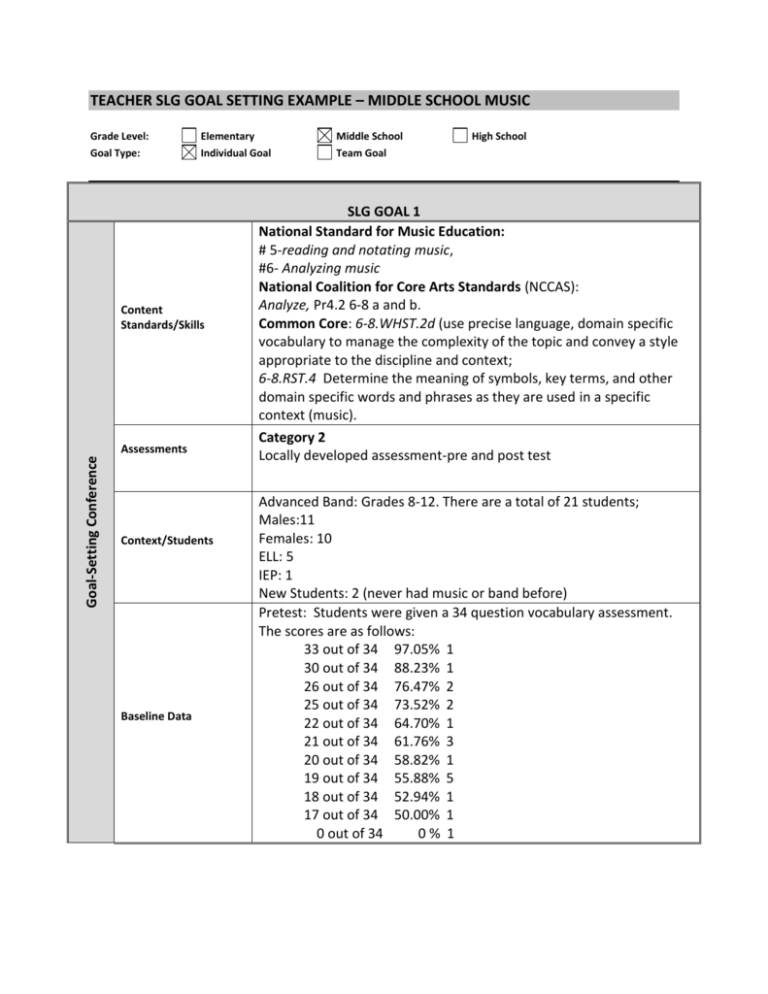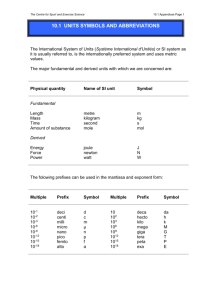Music
advertisement

TEACHER SLG GOAL SETTING EXAMPLE – MIDDLE SCHOOL MUSIC Grade Level: Goal Type: Elementary Individual Goal Goal-Setting Conference Content Standards/Skills Assessments Context/Students Baseline Data Middle School Team Goal High School SLG GOAL 1 National Standard for Music Education: # 5-reading and notating music, #6- Analyzing music National Coalition for Core Arts Standards (NCCAS): Analyze, Pr4.2 6-8 a and b. Common Core: 6-8.WHST.2d (use precise language, domain specific vocabulary to manage the complexity of the topic and convey a style appropriate to the discipline and context; 6-8.RST.4 Determine the meaning of symbols, key terms, and other domain specific words and phrases as they are used in a specific context (music). Category 2 Locally developed assessment-pre and post test Advanced Band: Grades 8-12. There are a total of 21 students; Males:11 Females: 10 ELL: 5 IEP: 1 New Students: 2 (never had music or band before) Pretest: Students were given a 34 question vocabulary assessment. The scores are as follows: 33 out of 34 97.05% 1 30 out of 34 88.23% 1 26 out of 34 76.47% 2 25 out of 34 73.52% 2 22 out of 34 64.70% 1 21 out of 34 61.76% 3 20 out of 34 58.82% 1 19 out of 34 55.88% 5 18 out of 34 52.94% 1 17 out of 34 50.00% 1 0 out of 34 0% 1 Student Growth Goal (Targets) Rationale Strategies Professional Learning and Support By the end of the semester, advanced band students will improve in their ability to recognize essential music vocabulary and symbols and describe their meaning as follows: 3 students who scored between 0-49 % will improve by 40 %. 9 students who scored between 50–60% will improve by 25%, 8 students who scored between 61 – 80% will improve by 15%, 1 student who scored between 81-90 % will improve a minimum of 5% and demonstrate understanding of a minimum of 5 advanced music vocabulary terms 1 student who scored 97.5% will improve to 100% and demonstrate understanding of a minimum of 10 advanced music vocabulary terms Advanced band students should be able to correctly define and identify musical vocabulary and symbols. These symbols and terminology begin to be introduced at the fifth grade level, and each symbol/vocab word continues to be used on a daily basis. However, students have trouble describing or identifying much of this vocabulary when asked to find it in their music. In order for the student to be a better performer, they must be able to recognize and understand what these symbols and terminology mean and apply it to their music. It is important that the student become self-reliant and not depend on the conductor to show them what to do whenever they play. Rather, they should recognize these musical instructions and apply them as they play, relying on the conductor as a guide rather than a master puppeteer! Word or symbol of the week. Students will be given a word or symbol and definition at the beginning of the week. Throughout the week, attention will be called to the word or symbol. A quiz at the end of the week will demonstrate student understanding. Students will teach a word/symbol concept to the class and demonstrate how to perform it, if applicable. Students will choose two symbols/vocab from the word list, (one they know well and one that they do not know as well) and teach a lesson. Journal and Music Teaching Professional Subscriptions, collaboration and sharing between other music education teachers in D9.






